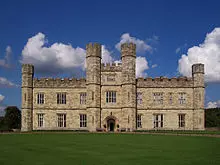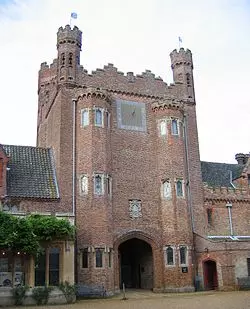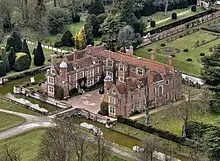


The Tudor architectural style, which flourished in England and Wales during the period of the Tudor dynasty (1485-1603) and beyond, represents a unique blend of medieval and Renaissance influences. It evolved from the Late Gothic Perpendicular style and gradually incorporated the trends of the Northern Renaissance from continental Europe. One subtype of Tudor architecture is Elizabethan architecture, which emerged around 1560 and continued into the early Stuart period.
In vernacular architecture, Tudor style became synonymous with half-timbered buildings. However, it is essential to note that the designation "Tudor style" is not entirely accurate, as it implies a continuous style throughout the Tudor dynasty and a style break at the accession of James I in 1603. The distinguishing feature of Tudor architecture is the arrangement of rectangular vertically oriented leaded windows framed by structural transoms and mullions, often with a "hooded" surround in stone or timber.
During the Tudor period, the architecture saw significant developments. The use of brick, imported from the Low Countries, became more widespread, and oriel windows became more elaborate. The period also witnessed the arrival of Italian artists in England, who contributed decorative features to prominent buildings like Hampton Court Palace and Layer Marney Tower.
The Dissolution of the Monasteries during Henry VIII's reign led to the redistribution of land and a secular building boom. Despite the decline in church building, civic and university structures proliferated, reflecting the increasing prosperity of the era. Brick gradually replaced traditional methods such as timber framing and daub, becoming the preferred material for even modest buildings. Tudor architecture in Scotland, influenced by French and Scottish court interactions, exhibited a more thorough adoption of continental Renaissance styles compared to its English counterparts.



Tudor architecture can be categorized into two groups: buildings constructed by the upper classes and those built by the lower classes. Buildings of the wealthy featured E or H-shaped floor plans, brick and stone masonry, elaborate glass windows, and large chimneys. They also showcased classical accents, wide wrought ironwork, and grand tapestries. Gardens and courtyards were meticulously landscaped.


In contrast, the houses of the lower classes were typically timber-framed and had simpler floor plans. These homes featured steeply pitched roofs, small diamond-shaped windows with lead casings, and half-timbered walls with white wattle and daub. Fireplaces, often large, served both heating and cooking purposes. The interiors typically had flagstone or dirt floors, and wooden staircases were common among the middle class and gentry.
While Tudor architecture is rooted in history, it continues to inspire contemporary design. The style has been revived in the 19th and 20th centuries, combining late Gothic, Tudor, and Elizabethan elements. Today, many grand country houses and public buildings in the United States and British Commonwealth countries draw inspiration from Tudor architecture. The enduring appeal of this architectural style reflects its timeless elegance and unique fusion of tradition and Renaissance influences.
To explore the richness and charm of Tudor architecture, you can visit various notable examples such as Henry VII's Richmond Palace, Leeds Castle from the reign of Henry VIII, and the magnificent Great Hall at Hampton Court Palace.

Tudor architecture is not only a testament to the past but also serves as a source of inspiration for future architectural endeavors. The intricate details, grandeur, and unique blend of styles make it a captivating and enduring architectural style. Whether you appreciate the historic significance or simply admire the aesthetic appeal, Tudor architecture continues to captivate the imagination of architects and enthusiasts alike.
Sources:












